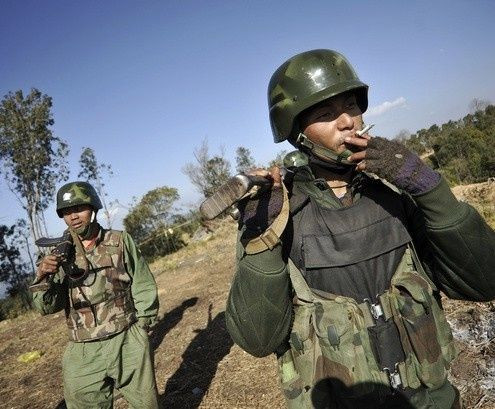Myanmar Crushes Kachin Rebels, America's Old Friends From World War II

BANGKOK, THAILAND - In Myanmar, the regime's helicopter gunships, mortars and rockets are successfully crippling a 52-year-long struggle for autonomy waged by mostly Christian, ethnic minority Kachin guerrillas, along the northernmost border with China.
The Kachin are unlikely to get outside help, despite having made in the past a very powerful friend: the United States. America befriended the Kachin during World War II, when the tough, jungle-savvy men helped U.S. troops infiltrate the region after Japan invaded and occupied mainland Southeast Asia's biggest country, which was then known as Burma.
"In the Second World War, we, the Kachin, fought alongside the U.S. with the 101st [Airborne Division of the U.S. Army] against the Japanese. ... We want them to be with us in our time of need, when we are in struggle," Kachin Youth Development Organization activist Hsai Zin said during a rally at the American Consulate in Chiang Mai, in northern Thailand, on Jan. 25.
During the past few days, Myanmar's superior forces steadily advanced against the 15,000-strong Kachin Independence Army, or KIA, after fighting began at the end of December. The rebels wear uniforms and fight from trenches, foxholes and bunkers, laying landmines, carrying supplies on their backs or on animals and treating injuries without anesthetics.
The force arrayed against them is vastly superior technologically, using fighter planes, possibly Chinese-built, and fearsome Russian-made Mi-35 helicopter gunships similar to the Mi-24 Hind "flying tanks" used by Soviet forces against Islamist guerrillas in Afghanistan during the 1980s.
Myanmar's Buddhist-majority government said it attacked, because the Kachin erected barbed-wire barriers near the rebel-held town of Laiza, which stopped government forces from entering and occupying the area, purportedly to distribute food.
Laiza is set amid hills and boasts modern buildings, reliable electricity, a local TV station and a thriving market fed by goods from Myanmar, China and elsewhere. Myanmar's military wants to dominate Laiza's border crossing with China and pacify the entire Kachin state.
Still, there were no immediate predictions of a full-scale surrender by the Kachin. They apparently plan to melt into the forested mountains and try hit-and-run tactics during the next several months to regain lost ground.
The KIA is the armed wing of the Kachin Independence Organization, or KIO, which was created in 1961.
They fought on and off against the military before a 1994-2011 cease-fire allowed both sides to exploit the region's natural resources. Then, competition grew over the mining of jade and gold, logging, agricultural businesses, hydropower and other investments.
Today, the region's 1 million Kachin are largely ignored by the outside world, as Myanmar emerges from decades of isolation. They have also been unable to gain practical support from Myanmar's Nobel Peace Prize laureate Aung San Suu Kyi, who said she hopes for a peaceful settlement but was unable to offer a solution.
In November, when U.S. President Barack Obama visited Myanmar, he hailed Suu Kyi as a pro-democracy icon, prompting expectations she would immerse herself in the bloody politics of the country's rebel wars and ethnic discrimination. But that has not happened. "This case is being handled by the government at the moment," Suu Kyi told Agence-France Presse in January.
During his visit, Obama also met President Thein Sein, who is now telling the international community that he will end the KIA's fight. "Our government will make genuine and lasting peace with the KIA," Thein Sein said on Jan. 19.
"We plan to hold a political dialogue in early 2013 after signing cease-fire agreements with 10 other armed groups," the president said, referring to a total of 50,000 other ethnic-minority rebels scattered elsewhere in the nation.
Meanwhile, though, the military assault on the Kachin is apparently aimed at sending a message to other ethnic rebels not to break their delicate cease-fire deals or escalate their struggles for autonomy.
The Kachin are the last remaining big rebel force refusing to sign a peace deal with the regime. Many of them fear a political solution would mean subjugation and end their dream for autonomy in a proposed federal system.
Tens of thousands of residents in and around Laiza, meanwhile, have fled, attracting concern from international human rights groups and nongovernmental organizations.
The Kachin struggle dates back to 1948, when Britain granted independence to their colonial possession of Burma, with its patchwork of ethnic groups. The British crafted the controversial Panglong Agreement, which was signed by various ethnic minorities in 1947. It would have allowed the Kachin, Chin, Karen, Karenni, Mon, Shan and other minorities to opt out of the new nation or enjoy enhanced autonomy.
After independence, that deal collapsed. Ethnic groups have fought for autonomy ever since, mostly in the country's eastern and northern zones bordering on China and Thailand.
© Copyright IBTimes 2025. All rights reserved.





















